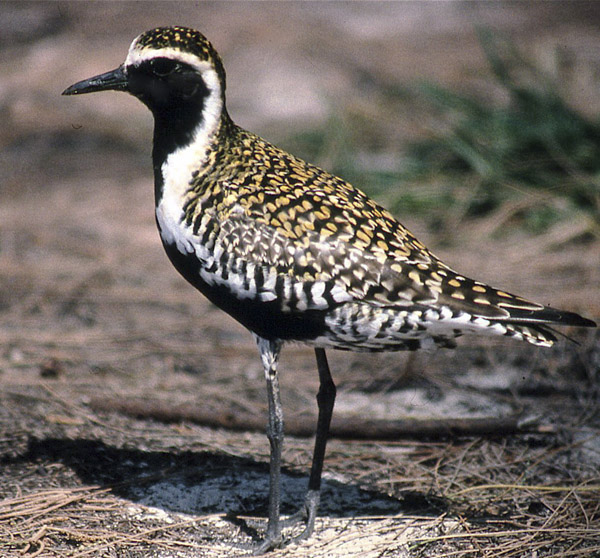Published in the Ocean Watch column, Honolulu Star-Advertiser © Susan Scott
April 6, 2015
Hawaii’s annual spring pageant is upon us, the superstars dazzling in their April outfits as they prance through backyards, across golf courses, among gravestones and between parked cars. The celebrities are Pacific golden plovers, our much-loved migratory shorebirds known in Hawaii as kolea.
Although kolea start molting into their striking breeding colors here in March, the birds stay single until they reach their Alaska breeding grounds. There males return to the same spot each year and, upon arrival, get busy rebuilding a ground nest of leaves and lichen.
 A male kolea in breeding colors.
A male kolea in breeding colors.
Courtesy O.W. Johnson
Females, though, aren’t usually faithful to either place or partner. Instead they shop around, looking for the handsomest male with the finest nest.
After choosing a homestead and mating, the female lays four huge eggs, their total weight equaling her own body weight. If a fox, raptor or caribou eats or breaks her eggs, a kolea can lay a replacement clutch in a week or so.
As if this reproductive labor isn’t astonishing enough, it all takes place after the 6-ounce birds have flown 3,000 miles over the Pacific Ocean. Nonstop. In three days.
If a nesting attempt fails due to weather or predation, adults can return to Hawaii as early as June. But if all goes well, the couple takes turns keeping the eggs, and later the chicks, warm and protected.
When chicks fledge, that’s the end of family togetherness. Mother plovers leave for Hawaii first, in early August, with fathers following a bit later. Chicks stay in their Arctic birth areas as long as the bugs and berries last, with most arriving here in October or November.
If you see a scrawny bird in a new place, it’s likely a recently landed chick that survived its first migration (on its own — there’s no adult guidance). But the struggle isn’t yet over. New arrivals must establish their own winter territory, often having to fight established plovers and other bird species for space.
Only about 20 percent of kolea chicks live to reproduce.
If you have a plover pecking and hopping around your yard year after year, it’s almost certainly the same bird, because both sexes return to the same wintering spot. And you could have that feathered friend for a long time. Some kolea live for 20 years or more.
Our grassy Easter parade isn’t going to last much longer. All kolea fit to migrate leave Hawaii within a few days of one another around April 25.
I know that countless Hawaii residents join me in wishing our little superbirds fair winds, strapping chicks and bugs galore. A hui hou.